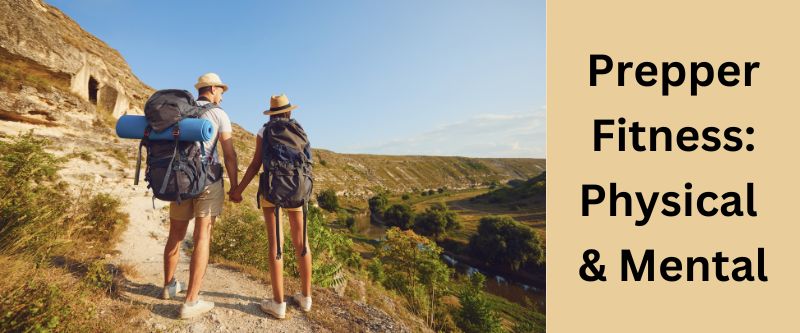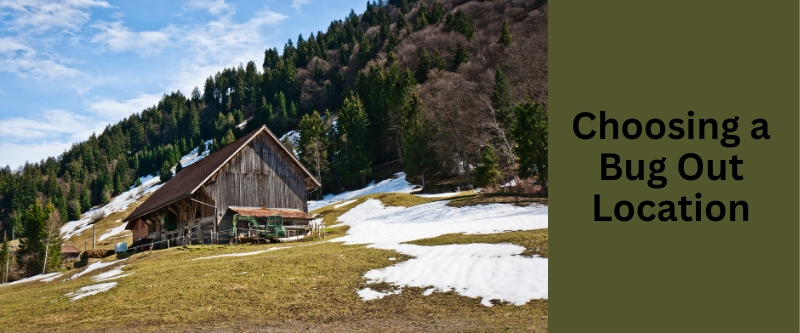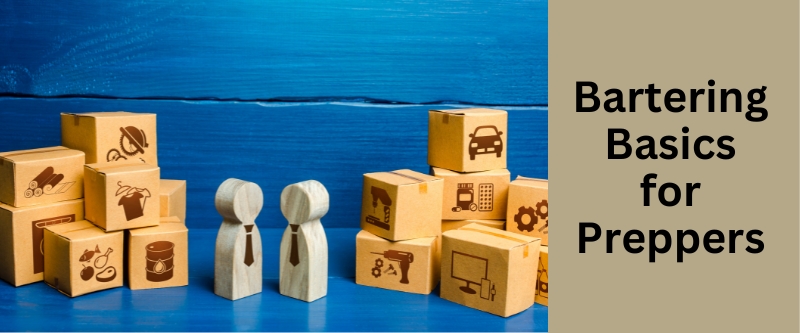Building Resilience for Survival
Table of contents
Introduction
In the realm of prepping and survivalism, an important element often takes a backseat to accumulating supplies and mastering survival skills. And that is physical and mental fitness.
While amassing food, water, and vital gear is undeniably crucial, the truth is that surviving a bug out or a SHTF (Sh*t Hits The Fan) scenario requires more than just having the right tools.
It demands a level of physical and mental resilience that can truly mean the difference between life and death to you and your family.
In a nutshell: Prepping includes prepping your body and your mind.
A Reality Check
Bugging out on foot and making a safe passage to the other side is physically and mentally demanding in a profound way. And it is something that must be considered in a practical context.
You have got to account for factors such as your own age and physical condition. And what about your partner, children, or elderly relatives? Are you collectively up to the challenge as a family unit?
When viewed in this light, bugging-out looks entirely feasible for a young couple without children. But, as you factor in family dynamics, age disparities, and potential disabilities, the odds of success diminish, even to a vanishing point. This perspective sheds light on why “bugging in” is usually a better option than bugging-out. Please see our separate post on Bugging Out: Why It’s the Last Resort.
The Vital Importance of Physical and Mental Fitness
Even so, whether you’re sheltering in place or venturing into the unknown, physical and mental preparedness is non-negotiable for surviving a SHTF scenario in good shape. The potential challenges encompass maneuvering through difficult landscapes, shouldering heavy loads, dealing with potentially hostile situations,and grappling with heightened stress and the unknown
This article delves into the significance of prepper fitness and the core facets of cultivating both physical and mental resilience. Plus, it offers actionable tips to ensure you’re equipped to tackle the adversity waiting for you in a SHTF scenario.
Our emphasis here is on the physical and mental fitness necessary for bugging out. But, that said, these things are important for bugging-in too. Remember that it’s possible that your bug in strategy may in the end fail. And you could find yourself with no option but to bug out. Besides, even if you are hunkered down, physical and mental fitness is important anyway.
Building Physical Health and Endurance
In a survival context, your body is your foundation. No matter your age, you can’t shoulder your bug-out and cover ground without being fit. You need a high level of physical health, physical strength, and endurance. So, let’s lay the groundwork for getting to that level.
Assessing Your Current Fitness Level
In a survival context, your body is your foundation. No matter your age, you can’t shoulder your bug-out and cover ground without being fit. You need a high level of physical health, physical strength, and endurance. So, let’s lay the groundwork for getting to that level.
Elevating Cardiovascular Conditioning
How to Measure Your Cardiovascular Endurance
The best measure of cardiovascular fitness is the VO-2 Max stress test, which is done on a treadmill under medical supervision..
However you can get an approximation by taking the Rockport 1-mile walk test and grading yourself.
Endurance Conditioning
There are no shortcuts to cardiovascular conditioning. You have just got to do the work.This means that you must walk, fast-walk, hike, bike, swim, jog, or run. You can’t cheat. Start with moderate-intensity workouts and progressively escalate intensity and duration.
By the way, if you walk, use Nordic Walking Sticks. And, if you have to bug-out on foot, use Trekking Poles. Practice with these things. Trekking poles help with stability, boost your progress, and double as self-defense equipment.
In case you haven’t heard of it, here’s what we mean by Nordic Walking:
Bottom line: Successfully enduring long distance foot travel with a load on your back and in a high-stress situation hinges on cardiovascular fitness.
Reality Check (Again!) – How Far Can I Go on Foot?
We interrupt this discussion on fitness to interject some bottom line thinking.
So you have shouldered your bug-out backpack. It weighs about 30 pounds.You have put on some decent hiking boots, although they are new and you haven’t worn them much. And you haven’t done this before.
You are not in bad shape but not great either. You are about to head out of the door to see how this all shakes out on the road. How far do you think you’ll get before you run out of steam?
My guess: Three to five miles tops. And you’ll have blisters.
But wait! How far away is your theoretical bug-out destination?
The point: A walkout bug-out is not something you attempt lightly. And, if you are serious about it, you have got to train for it. So include this in your cardiovascular and fitness regime. It’s not hard. Make it a rule that every time you go for a walk, shoulder your bug-out bag. And make sure you wear-in your boots.
Forging Strength
How to Assess Your Physical Strength
Are you strong enough to survive? You can get an assessment of how strong you are by self-testing. Here is a great site offering both strength and endurance tests.
Boosting Your Strength
Same as with cardio, If you want to get stronger, there is no alternative to putting in the work. So set up a routine. You don’t need special equipment. So, no excuses
Embed strength training regimens to cultivate muscles and amplify overall power. Use bodyweight exercises like push-ups, squats, and planks to cultivate functional strength. Augment this with weightlifting and resistance training to target specific muscle groups.
You can find plenty of help with this on-line. Here are some examples.
How to Plank Properly
Fostering Flexibility and Mobility
Keeping limber and maintaining mobility will protect you from injury on the bug-out trail.
Assessing Your Mobility
See if you can pass these 8 mobility tests:
Things You Can Do
Incorporate regular stretching routines into your fitness regimen to maintain mobility and muscle elasticity. Yoga and Pilates will help you with this.
You can find plenty of help with this on-line. Here are some examples.
Mastering Balance and Coordination
Balance and mobility can keep you safe when navigating difficult terrain on your bug-out. And they can help you at home too, especially if you are getting on in years.
Try these balance exercises, courtesy of a physical therapist:
Balance Exercises
And here are workouts for strength, balance, and mobility.
Nutrition and Hydration for Optimal Performance
Make sure you have a balanced diet of lean proteins, whole grains, fruits, vegetables, and wholesome fats. Proteins help with muscle repair and growth and complex carbohydrates bring you vitality. Proper hydration is key. Make sure you drink at least 64 ounces of water per day. You can use one of these motivational bottles to keep you on track at home. And use a hydration bladder on the bug-out trail.
Embracing Recovery and Rest
Rest and recovery are as important to your physical fitness regimen as the exercises themselves.
Recovery is a cornerstone of fitness. It replenishes your store of energy (glycogen) and gives your muscles time to repair themselves.
Rest and sleep play significant roles in rejuvenation and reinvigoration post exertion. And sleep itself plays a role in hormonal equilibrium and maintenance of cognition.
However, at the same time that you are fortifying your body for the bug-out, remember that mental fortitude is just as important. And that is what we will get into next.
Cultivating Mental Resilience and Preparedness
Mental resilience is just as important as physical fitness in survival scenarios. Your mental state affects decision-making, impacts problem-solving aptitude, and defines your perspective in high-stress situations.
Reinforcing mental resilience and preparedness now will prevent panic and strengthen strategic thinking when SHTF happens.
Here’s how to fortify your mind for survival:
Embracing a Survival Mindset
Survival scenarios require quick thinking and adaptability. Creating a survival mindset means conditioning your imind to assess situations objectively, make rational choices, and keep composure under duress.
Begin by internalizing the philosophy that trials are conduits for evolution. Visualizations, mental drills, and scenario simulations can make your psyche positively responsive when facing threats..
Navigating Stress
Survival scenarios are obviously stressful. So acquiring deft stress management techniques will forestall frenzy and bestow the mental clarity necessary to think through an emergency situation.
Breathing routines, meditation, and mindfulness exercises will help anchor your mind amidst turmoil and keep anxiety in check. So embed these techniques into your daily routine.
Breathing is key. Here is some tuition on deep breathing.
Deep Breathing Exercises
Reinforcing Problem Solving
In a survival scenario you have got to be an expert and adaptable troubleshooter. So fortify your problem-solving abilities by working through puzzles and brain-teasers. Play video games, seriously. Check these reasons to play video games. They help develop cognition. Don’t scoff at this.
Cultivate Mental Fortitude
Mental tenacity befits those facing trial and tribulation. And mental toughness can result from pushing yourself into doing tough things physically. So embrace discomfort and challenge. Exercise to the point of exhaustion and then take icy showers.
I know. That sounds terrible. But you will feel exhilarated afterward. And this kind of resolve fosters mental fortitude.
Strengthen Emotional Resilience
Emotional resilience helps you maintain mental equilibrium and self control during high-stress episodes. You can foster emotional resilience by embracing gratitude. Maintain a gratitude journal and take other gratitude exercises. Gratitude gives you a sense of proportion. And this is important when everyone around you is running around with their hair on fire in a SHTF scenario.
Fostering a Preparedness Psyche
Maintain a preparedness ethos. Do this by regularly reviewing your preparedness plans and supplies. This will help you keep prepping top of mind but without obsessing about it.
This exercise will help you with mental poise and at the same time prevent anxiety. You will have the confidence that because you have prepared your best, you will perform your best.
We talk about this in some detail later in this article. This is where we outline all the various facets of being physically prepared. And the point is that, unless you actually do take these steps towards physical preparedness, you will sabotage your mental preparedness too.
Mental Dress Rehearsals through Visualization
Through visualization and mental rehearsals you project yourself as overcoming the daunting challenges of SHTF scenarios. In this exercise you vividly envision in your mind the possible ways an emergency might develop and how you will deal with it. This will develop a kind of mental muscle memory that will help you in a stressful SHTF scenario.
Strength in the Social Fabric
Foster friendships with kindred preppers. Help create a community, especially among neighbors who share prepping interests and concerns. There are a growing number of people who sense that trouble is brewing but don’t want to be thought of as crazy. So they hide their concerns. See if you can find them. Create local allies. Mutual self-help is a good thing in a SHTF scenario.
Orchestrating Prepper Fitness and Prepper Skills
Prepper fitness and prepper skills can be orchestrated into your lifestyle. We have already discussed the purely physical and mental aspects of prepping. This is what it takes to survive and thrive, whether on the bug-out trail or hunkered down inside your bug-in fortress. And we have seen that what will make this a success is consistency of practice.
However, we should not neglect the cultivation of the prepper knowledge and skills that we will need to rely on that SHTF scenario. So we suggest you look at the whole thing as an orchestration. You can use the development of knowledge and skill as part and parcel of your mental and physical preparation.
The point is that this development requires both our mental and our physical effort. So what we will do here is lighten up a bit and take some liberties with artistic license and musical imagery – just to make the point.
Wilderness Symphony – The Sonata of Survival Skills
Wilderness survival skills stand guard for preppers entrapped within remote or natural domains. These dexterities encompass:
Shelter Choreography: Mastery in erecting shelters from natural resources, safeguarding against the elements’ fury.
Pyrotechnic Mastery: Proficiency in kindling flames through friction, sparks, or solar alchemy.
Aquatic Alchemy: Acumen in discerning water sources and purifying liquid sustenance for secure consumption.
Botanical Ballet: Insight into edible flora and foraging finesse to supplement stores of sustenance. Navigation Artistry: Proficiency in harnessing maps, compasses, and natural landmarks to evade ensnarement in labyrinthine entanglements.
A Symphony of Compassion – Orchestration of Medical and First Aid
First aid and medical skills stand guard against affliction when professional medical help lies distant. These disciplines encompass:
Primal First Aid Choreography: Mastery in dispensing first aid for lacerations, burns, fractures, and common traumas.
Rhythmic CPR and AED Symphony: Proficiency in cardio-pulmonary resuscitation’s harmonics and automated external defibrillator’s cadence.
Wound Tapestry and Infection Sonnet: Adeptness in cleansing, disinfection, suturing, and meticulous dressing of wounds.
Medical Improvisation Ballet: Proficiency in conjuring medical provisions and implements in resource-scarce settings. Herbal Remedial Overture: Familiarity with herbal constituents as nature’s resource for natural healing.
Sentinels of Safety – The Parados of Self-Defense and Security Skills
Self-defense and security skills stand guard over you and your loved ones in the face of peril. These skills encompass:
Basic Self-Defense Choreography: Mastery in evasion techniques against assailants and immobilization maneuvers.
Firearm Artistry: Mastery in firearm handling, marksmanship, and safety, within lawful confines and personal comfort.
Improvised Armament Ballet: Proficiency in transforming mundane objects into tools of self-defense.
Situational Symphony: Mastery in environmental assessment, discerning potential threats in your surroundings. Haven Harmony: Proficiency in fortifying domicile or improvised shelter against uninvited intrusion.
Echoes of Unity – Ballad of Communication and Networking
Communication and networking harmonies, primed for emergencies, stand paramount. These skills encompass:
Ham Radio Sonata: Proficiency in orchestrating ham radios for long-range discourse when conventional means fail.
Signal Stanzas: Mastery in diverse signaling methods: Morse code, mirrors, whistles, smoke signals – all synching in the symphony of emergency.
Radio Frequency Etudes: Acumen in radio frequencies and emergency channels for harmonious discourse. Community Symphony: Proficiency in weaving webs of rapport and uniting like minded souls for mutual aid and enlightenment.
Culinary Cantata – Food Preservation and Preparedness Crescendo
Food preservation and preparedness furnish your nourishment in times of tumult. These skills encompass:
Canning Crescendo: Mastery in preserving fresh harvests through canning and fermentation for protracted sustenance.
Edible Dehydration Ballet: Adeptness in dehydrating comestibles into lightweight, shelf-resident repasts.
Gastronomic Rotation Rhapsody: Adeptness in rotational nourishment practice, ensuring the viability of your stored rations. Hunting and Angling Sonata: Proficiency in hunting, trapping, and angling – fusing sustenance with strategic self-reliance.
Resilient Lullaby – Mental Resilience and Stress Harmony
Mental resilience and stress harmonies nurture lucidity and optimism through tribulations. These disciplines encompass:
Mindfulness Prelude: Practice of mindfulness and meditation symphonies – serenading stress’s decline and mental lucidity’s ascent.
Stress Management Cadence: Mastery in orchestrating harmonies of stress, anxiety, and panic relief, yielding to measured resolve.
Positive Visualization Sonata: Cultivation of constructive ethos through visualization serenades and affirmations. Dilemma’s Duologue: Development of predicament-dissolving cadences, addressing quandaries with acumen.
Ingenious Sonata – Resourcefulness and Adaptability Concerto
Resourcefulness and adaptability, the crux of harnessing available resources, resonate melodiously. These disciplines encompass:
MacGyver Prelude: Mastery in transmuting ordinary objects into extraordinary tools, enacting life-saving alchemy.
Rebirth of Purpose Overture: Proficiency in transforming, reviving, repurposing, and exalting materials for diverse ends.
Innovative Gastronomy Opus: Mastery in culminating culinary symphonies, embellishing gastronomy in paucity.Seamstress and Sartor Sonata: Adeptness in sutures, fashioning new life into garments, gear, and accouterments.
Conclusion: A Tapestry of Resilience
OK. That last passage was a bit over the top. But the whole point of this was to illustrate the large variety of skills it is necessary to master as a prepper-survivalist. You’re not merely bracing yourself for specific adversities; you’re conducting a symphony of resilience across the whole spectrum of survival.
Surviving a SHTF scenario transcends the mere accumulation of supplies; it invokes a symphony of physical and mental resilience. By seamlessly weaving these threads together, setting practical, and orchestrating real-life dress rehearsals, you will be properly poised and postured to deal with and survive the SHTF scenario. This is whether you are bugged out or hunkered down.
FAQs
Q: What Role Does Prepper Fitness Play?
A: Prepper fitness imbues you with physical and mental resilience, imperative for navigating emergencies adeptly. It augments your capacity for health, mobility, and astute decision-making under duress.
Q: How Does Physical Fitness Resonate in Survival?
A: Physical fitness enhances endurance, strength, and holistic wellness. It’s the bedrock for executing pivotal tasks such as evacuation, shelter construction, and resource gathering. It bolsters immune resilstence against environmental hazards.
Q: Can Fitness Thrive Sans Gym or Gear?
A: Unquestionably! Prepper fitness thrives in adaptability. Bodyweight exercises like push-ups and lunges require no apparatus. Hiking, running, and swimming require minimal gear, yielding maximal benefits.
Q: What About Disabilities or Physical Limitations?
A: Prepper fitness is adaptive. Seek counsel from healthcare professionals to devise tailored plans. Focus on functional motions, flexibility, and exercises tailored to your capacities. Tailor your hunker down and bug-out strategies accordingly.
Q: Can Mental Resilience Be Amplified?
A: Certainly. Fortify mental resilience through meditation, mindfulness, affirmative visualization, and stress modulation. A robust support network, honed problem-solving skills, all engender mental strength.
Q: For Novices in Survival, What Steps to Take?
A: Start by mastering the essentials. Search the web, enroll in survival courses, absorb literary wisdom, observe video tutorials, and practice skills like fire-starting, shelter crafting, and navigation. Proficiency flourishes with practice.
Q: Bug In or Bug Out? The Conundrum
A: Contemplate the nature of the threat, resource accessibility, the shelter’s security, and the inhabitants’ abilities.
Q: Can All Age Cadres Embrace Prepper Fitness?
A: Absolutely. Customize prepper fitness regimens, tailoring to children’s vigor and the elderly’s acumen. Foster unity via family-friendly pursuits like nature strolls.
Q: Crafting the Bug-Out Bag – How?
A: Delve into requisites. Gauge survival duration, terrain, and climate. Cherry-pick an apt backpack and populate it with essentials – sustenance, hydration, attire, shelter, medical supplies, and tools.
Q: Fitness or Survival Skills? Conundrum Resolved.
A: The binary dissolves, yielding a harmonious concert. Fitness amplifies physical efficacy; skills provide cognitive prowess. Strive for equipoise, embracing both as the symphony of preparedness harmonizes.





Leave a Reply